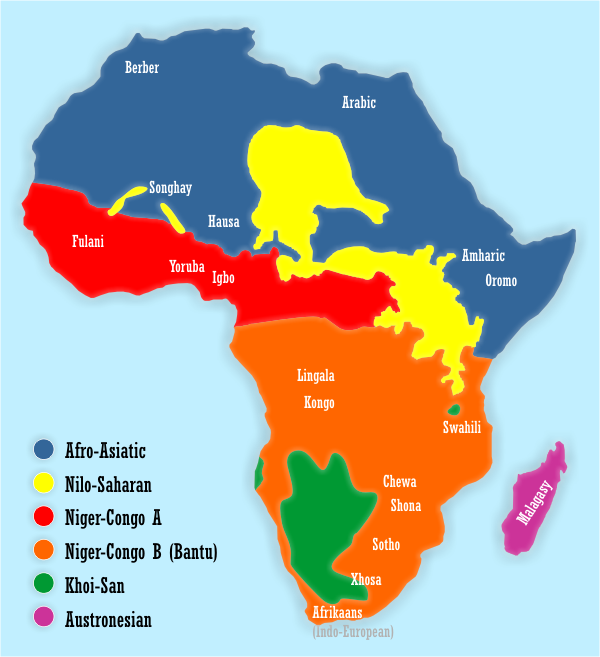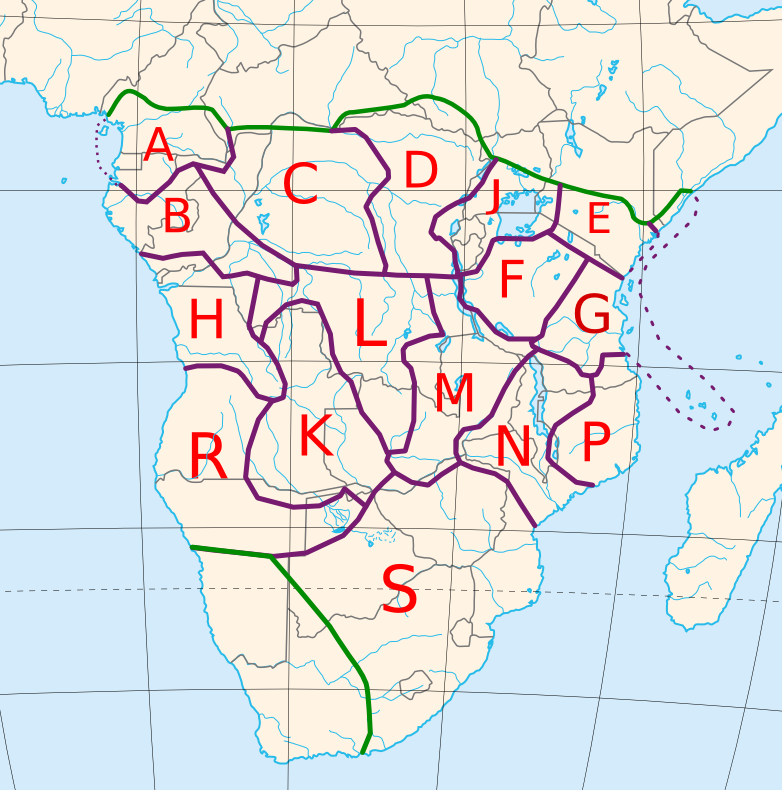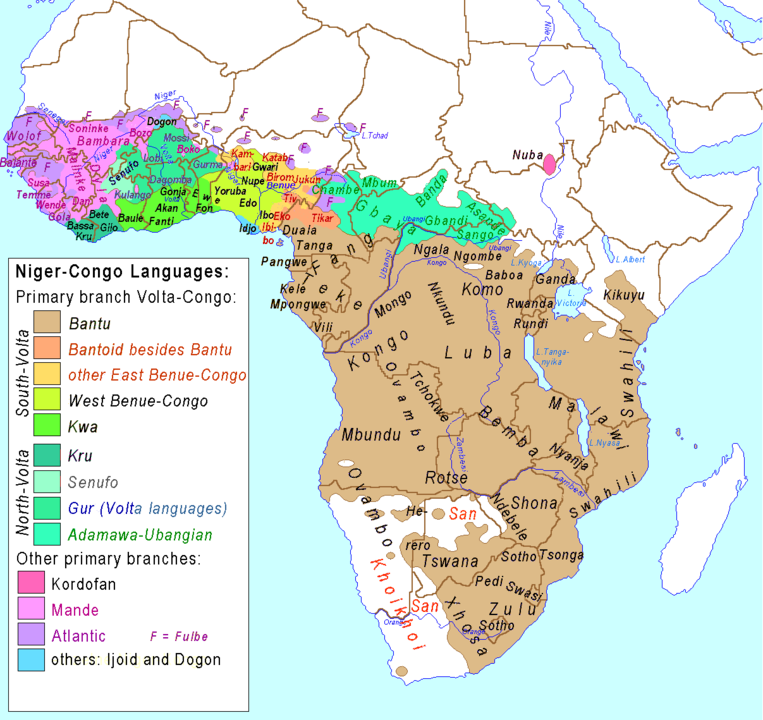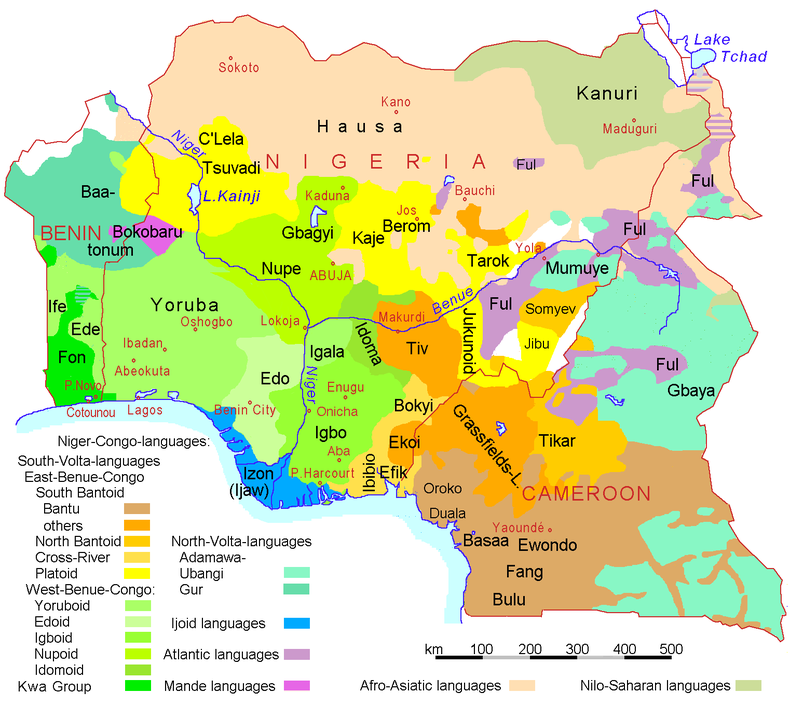Bantu languages

The Bantu languages are a large family of languages spoken by the Bantu peoples in the southern half of Africa. They form the largest branch of the Southern Bantoid languages.
The total number of Bantu languages ranges in the hundreds, depending on the definition of “language” versus “dialect”, and is estimated at between 440 and 680 distinct languages. For Bantuic, Linguasphere (Part 2, Transafrican phyllo sector, phylo zone 99) has 260 outer languages (which are equivalent to languages, inner languages being dialects). McWhorter points out, using a comparison of 16 languages from Bangi-Moi, Bangi-Ntamba, Koyo-Mboshi, Likwala-Sangha, Ngondi-Ngiri and Northern Mozambique, mostly from Guthrie Zone C, that many varieties are mutually intelligible.
The total number of Bantu speakers is in the hundreds of millions, estimated at around 350 million in the mid-2010s (roughly 30% of the total population of Africa or roughly 5% of the world population). Bantu languages are largely spoken southeast of Cameroon, throughout Central Africa, Southeast Africa and Southern Africa. About one-sixth of the Bantu speakers, and about one-third of Bantu languages, are found in the Democratic Republic of the Congo alone (c. 60 million speakers as of 2015). See the list of Bantu peoples.
The Bantu language with the largest total number of speakers is Swahili; however, the majority of its speakers use it as a second language (L1: c. 16 million, L2: 80 million, as of 2015).
Other major Bantu languages include Zulu with 12 million speakers and Shona with less than 10 million speakers (if Manyika and Ndau are included)(Zimbabwe has Kalanga, Matebele, Nambiya and Xhosa speakers). Ethnologue separates the largely mutually intelligible Kinyarwanda and Kirundi, which together have 20 million speakers.
Name

The similarity among dispersed Bantu languages had been observed as early as the 17th century. The term Bantu as a name for the group was coined (as Bâ-ntu) by Wilhelm Bleek in 1857 or 1858, and popularised in his Comparative Grammar of 1862. He coined the term to represent the word for ‘people’ in loosely reconstructed Proto-Bantu, from the plural noun class prefix *ba- categorizing ‘people’, and the root *ntʊ̀- ‘some (entity), any’ (e.g. Zulu umuntu ‘person’, abantu ‘people’).
There is no indigenous term for the group, as Bantu-speaking populations refer to themselves by their endonyms, but did not have a concept for the larger ethnolinguistic phylum. Bleek’s coinage was inspired by the anthropological observation of groups frequently self-identifying as ‘people’ or ‘the true people’ (as is the case, for example, with the term Khoekhoe, but this is a kare ‘praise address’ and not an ethnic name).
The term narrow Bantu, excluding those languages classified as Bantoid by Guthrie (1948), was introduced in the 1960s.
The prefix ba- specifically refers to people. Economically, the term for cultural objects, including language, is formed with the ki- noun class (Nguni ísi-), as in KiSwahili (Swahili language and culture), IsiZulu (Zulu language and culture) and KiGanda (Ganda religion and culture).
In the 1980s, South African linguists suggested referring to these languages as KiNtu. The word kintu exists in some places, but it means ‘thing’, with no relation to the concept of ‘language’. In addition, delegates at the African Languages Association of Southern Africa conference in 1984 reported that, in some places, the term Kintu has a derogatory significance. This is because kintu refers to ‘things’ and is used as a dehumanizing term for people who have lost their dignity.
In addition, Kintu is a figure in some mythologies.
In the 1990s, the term Kintu was still occasionally used by South African linguists. But in contemporary decolonial South African linguistics, the term Ntu languages is used.
Origin
The Bantu languages descend from a common Proto-Bantu language, which is believed to have been spoken in what is now Cameroon in Central Africa. An estimated 2,500–3,000 years ago (1000 BC to 500 BC), speakers of the Proto-Bantu language began a series of migrations eastward and southward, carrying agriculture with them. This Bantu expansion came to dominate Sub-Saharan Africa east of Cameroon, an area where Bantu peoples now constitute nearly the entire population. Some other sources estimate the Bantu Expansion started closer to 3000 BC.
The technical term Bantu, meaning “human beings” or simply “people”, was first used by Wilhelm Bleek (1827–1875), as the concept is reflected in many of the languages of this group. A common characteristic of Bantu languages is that they use words such as muntu or mutu for “human being” or in simplistic terms “person”, and the plural prefix for human nouns starting with mu- (class 1) in most languages is ba- (class 2), thus giving bantu for “people”. Bleek, and later Carl Meinhof, pursued extensive studies comparing the grammatical structures of Bantu languages.
Classification

The most widely used classification is an alphanumeric coding system developed by Malcolm Guthrie in his 1948 classification of the Bantu languages. It is mainly geographic. The term ‘narrow Bantu’ was coined by the Benue–Congo Working Group to distinguish Bantu as recognized by Guthrie, from the Bantoid languages not recognized as Bantu by Guthrie.
In recent times, the distinctiveness of Narrow Bantu, as opposed to the other Southern Bantoid languages, has been called into doubt (cf. Piron 1995, Williamson & Blench 2000, Blench 2011), but the term is still widely used.
There is no true genealogical classification of the (Narrow) Bantu languages. Until recently most attempted classifications only considered languages that happen to fall within traditional Narrow Bantu, but there seems to be a continuum with the related languages of South Bantoid.
At a broader level, the family is commonly split in two depending on the reflexes of proto-Bantu tone patterns: Many Bantuists groups together parts of zones A through D (the extent depending on the author) as Northwest Bantu or Forest Bantu, and the remainder as Central Bantu or Savanna Bantu. The two groups have been described as having mirror-image tone systems: where Northwest Bantu has a high tone in a cognate, Central Bantu languages generally have a low tone, and vice versa.
Northwest Bantu is more divergent internally than Central Bantu, and perhaps less conservative due to contact with non-Bantu Niger-Congo languages; Central Bantu is likely the innovative line cladistically. Northwest Bantu is clearly not a coherent family, but even for Central Bantu, the evidence is lexical, with little evidence that it is a historically valid group.

Another attempt at a detailed genetic classification to replace the Guthrie system is the 1999 “Tervuren” proposal of Bastin, Coupez, and Mann. However, it relies on lexicostatistics, which, because of its reliance on overall similarity rather than shared innovations, may predict spurious groups of conservative languages that are not closely related. Meanwhile, Ethnologue has added languages to the Guthrie classification which Guthrie overlooked, while removing the Mbam languages (much of Zone A), and shifting some languages between groups (much of zones D and E to a new zone J, for example, and part of zone L to K, and part of M to F) in an apparent effort at a semi-genetic, or at least semi-areal, classification. This has been criticized for sowing confusion in one of the few unambiguous ways to distinguish Bantu languages. Nurse & Philippson (2006) evaluate many proposals for low-level groups of Bantu languages, but the result is not a complete portrayal of the family. Glottolog has incorporated many of these into their classification.
The languages that share Dahl’s law may also form a valid group, Northeast Bantu. The infobox at right lists these together with various low-level groups that are fairly uncontroversial, though they continue to be revised. The development of a rigorous genealogical classification of many branches of Niger-Congo, not just Bantu, is hampered by insufficient data.
Computational phylogenetic analyses of Bantu include Currie et al. (2013), Grollemund et al. (2015), Rexova et al. 2006, Holden et al., 2016, and Whiteley et al. 2018.
Also, See other Indigenous people.
African Great Lakes
Hadza people, Sandawe people, Twa people, Bangweulu Batwa, Great Lakes Twa, Kafwe Twa, Lukanga Twa, Nilo-Saharan, Kalenjin people, Maasai people, Samburu people, Bantu languages, Abagusii People, Kikuyu people, Luhya people, Bukusu, Afroasiatic, Iraqw people, Rendille people.
——————————————————————————